PUBLICATIONS
PRiME proudly produces several products, including Education Reports, Policy Briefs, Parent PRiMERs, Growth Reports, and Education Profiles.
The Saint Louis University (SLU) Billiken Teacher Corps (BTC) offers two pathways for current and aspiring Catholic school educators to earn their Master of Arts in Teaching (MAT) and certification (if needed): Cura Community and MAT Magis.
This report examines the effect integration had on the Black teacher workforce in Missouri from 1954–1970. We outline how Black teachers were displaced in the seventeen southern and border states as these states moved toward compliance with Brown. We present data on the displacement of Black teachers in these seventeen states—with a focus on Missouri. Our report concludes with an analysis of trends in the student-teacher racial parity index in Missouri and implications for policymakers about how this history connects to the contemporary status of student-teacher demographics in Missouri public schools.
Abstract: When looking at the actual impact that schools are having on student learning, it is vital to look at student growth. This is especially important for schools that enroll high percentages of low-income students. Opposite of growth are single point-in-time measures such as proficiency, which do not adjust for where students start the year. Missouri has the best growth model in the country. This report combines three years of growth data, and then looks at the quartile of Missouri schools enrolling the highest percentage of low-income students. The data show that some of the highest growth schools in Missouri also enroll some of the highest percentages of low-income students. Recognizing, rewarding and replicating the successes of these schools is the best path to improving outcomes for the state’s most vulnerable students.
This 1st Edition of PRiME’s Missouri Three Year Statewide Growth Report which covers data from the 2021-22 and 2023-24 school years.
When we talk about how students are doing in subjects like reading and math, it’s more helpful to look at how much they grow over time rather than just where they stand at one moment. This report continues the PRiME Center’s efforts to highlight Missouri’s excellent schools by examining student growth in the state's most rural schools over the last three years.
Mentoring of early-career teachers is a key strategy used by the Missouri Department of Elementary and Secondary Education (MO DESE) to improve teacher retention. To that end, MO DESE needs better information on the features of mentoring that early-career teachers receive and the features that may be related to teacher retention. At the request of MO DESE, the Regional Educational Laboratory Central conducted a study of the frequency, duration, activities, and topics addressed in the mentoring received by first-year teachers in Missouri who registered for state-delivered teacher induction workshops in the 2022/23 school year. The study also sought to identify which mentoring features were related to teachers’ likelihood of returning to teach in the same school district for a second year, as measured by teacher employment records.
The number of people in Missouri without stable housing is rising; this includes families, children and youth. The McKinney-Vento Homeless Assistance Act–initially established in 1987–requires schools to collect data on and provide support for students facing homelessness. However, little is known about the extent of students and families experiencing homelessness, the policies and programs that support these vulnerable students or their schooling opportunities and outcomes. In this report, I describe the McKinney-Vento Homeless Assistance Act, describe recent homelessness trends, provide an overview of McKinney-Vento participation and briefly describe outcomes for students supported through McKinney-Vento programs across the state of Missouri. I conclude with a discussion of the importance of addressing homelessness in relation to student mobility.
Teacher mobility in Missouri and most states across the country reached long-term highs following the pandemic over the 2022-23 school year. Though mobility declined in 2023-24, several worrying trends have persisted across the state, including higher turnover among teachers working in urban, rural, and disproportionately low-income schools. Turnover is also disproportionately high among the state’s teachers of color, though the state has more than doubled the recruitment of new teachers of color over the past decade. As legislators and education leaders work to support Missouri’s teacher workforce, policy formation must engage with labor conditions specific to particular school and teacher characteristics to effectively improve outcomes for teachers and the students they educate.
In June 2020, Saint Louis University launched the SLU/YouGov poll to provide researchers and policymakers with an assessment of Missouri likely voters’ opinions on relevant political and educational issues. Some questions were asked in multiple polls to monitor trends over time, while others were relevant to potential policy changes that may have impacted the education sector at a given time. Here, we summarize the findings from nine polls conducted from 2020–2025 to identify trends in public opinion on Missouri’s education issues.
The newest data from the Department of Elementary and Secondary Education finds that more than one in five K–12 students were chronically absent in the 2023–24 school year. From 2019 to 2024, nearly 91% of Missouri districts (499 total) have experienced a rise in chronic absenteeism—defined as missing at least ten percent of scheduled school days. Here, we explore key trends from the most recent Missouri attendance data.
A comprehensive look at public school enrollment in Missouri, the Kansas City Metro Area and the St. Louis Metro Area.
PRiME Center’s recent report highlights the Missouri schools serving students from low income households that are producing large gains in reading and math.
This 4th Edition of PRiME’s annual Missouri Statewide Growth Report covers data from the 2022-23 and 2023-24 school years.
The St. Louis Teaching Fellows (STL TF) program at Saint Louis University (SLU) continues to place teachers in St. Louis area public and charter schools by providing a route to teach while simultaneously earning teaching certification and a Master of Arts in Teaching (MAT) degree. The impact has grown to two active cohorts (24 students) and three classes of graduates (36 students).
This report sheds light on the relationship between four-day school weeks and attendance in Missouri and Arkansas schools.
There are over one million school-age children in Missouri, and we estimate 61,000 (6% of all school-age children) are homeschooled. Missouri is one of 29 states that does not require homeschooling to be reported. Using methods that can be replicated elsewhere with publicly available data, we test three approaches to estimating homeschool participation: using American Community Survey (ACS) data; subtracting public and estimated private school counts from ACS school-age totals; and polling parents. We comment on the usefulness and limitations of each approach and provide a model for researchers seeking to estimate homeschooling trends in states that lack administrative data.
This report examines the unique challenges to and opportunities for school belonging for students in special education, along with best practices to support school belonging for special education students.
This report details Missouri teachers’ supplemental (non-base) pay and the Career Ladder program for teachers.
Currently, over a third of public school districts in Missouri utilize a four-day school week (4DSW). The overwhelming majority that currently use a shortened school week are small, rural school districts. The primary reason cited by districts for transitioning to the 4DSW is to recruit and retain certified educators in an increasingly competitive workforce marketplace. While, up to this point, the four-day school week has been a rural school district phenomenon, this is beginning to change as larger districts also struggle to find and retain staff. This study examined the 4DSW influence on job applications to the Independent School District (ISD), which adopted a four-day school week for the 2023-2024 school year. With over 14,000 students and over 1,200 certified staff, ISD is by far the largest 4DSW district in Missouri. As policymakers analyze the 4DSW, it is important to investigate how the size and diversity of a school impact a school district's ability to attract and retain teachers.
In this report, we analyze the results of a survey sent to 900 Missouri and Arkansas parents, asking them their opinions about four-day school weeks, homeschooling, college likelihood, teacher salaries and entering the workforce, and school vouchers.
In this report, we dive into the results, focusing specifically on the education questions posed to voters on the Fall 2024 SLU/YouGov poll.
This brief documents changes in Missouri public school teacher retention during the COVID-19 pandemic and examines changes in teacher retention in districts that adopt a four-day school week calendar.
This 3rd Edition of PRiME’s annual Growth Reports covers data from the 2021—2022 school year.
This 3rd Edition of PRiME’s annual Beating the Odds Growth Report covers data from the 2021—2022 school year.
In this education report we first provide some key background information regarding student mobility and its impact. We then use public data to describe what student mobility looks like across Missouri in comparison to neighboring states. Next, we call attention to the discrepancies in existing Missouri student mobility data and describe possible reasons for these discrepancies. We conclude with implications for education researchers and policy makers.
Since 2020, Saint Louis University (SLU) has worked with YouGov to poll Missouri citizens on current issues in politics and education. The PRiME Center funded a poll presented to 900 likely Missouri voters from February 14–February 26, 2024 to inform stakeholders on public opinion surrounding political and education-related policy issues. In this report, we dive into the most recent education results.
Emergent Bilinguals (EBs), or students with a home language other than English, are a diverse group of students who bring additional linguistic assets to the classroom. Drawing on six decades of federal legislation and landmark court cases, the brief outlines the evolution of protections for EBs and examines how Missouri’s Department of Elementary and Secondary Education (DESE) implements these policies through identification, instruction, and assessment practices. The report also highlights ongoing challenges, including reduced federal funding and limited teacher preparation in English Language Development. We conclude with recommendations for community members, educators, and educational policy makers
This brief analyzes Missouri voters’ perceptions of public school quality using nine waves of the SLU/YouGov poll from 2020–2025 (N=7,281).
The Missouri Learning Standards (MLS) are pivotal for instructional planning, implementation, and assessment across the state of Missouri. In this report we describe the MLS and share a summary of grade-level and course-specific learning expectations across various subject areas. We conclude with recommendations for educators and educational policy makers.
This brief explores how Missouri school districts respond to the rise of artificial intelligence (AI) in instruction. While the state lacks a formal AI education policy, local districts have begun implementing guidelines and integrating AI tools into classrooms. We describe current AI policies and implementation practices in Missouri school districts. We also provide recommendations for equitable, ethical, and effective AI adoption in Missouri education.
The National Assessment of Educational Progress (NAEP) exam—also known as The Nation’s Report Card—has been given to students since 1969. We discuss nationwide and Missouri-specific trends from the 2024 data release of 4th and 8th Grade Mathematics and Reading scores, and compare the results to the state’s own Missouri Assessment of Progress (MAP). Since 2019, the two sets of tests tell very different stories.
Since 2020, SLU has partnered with YouGov to poll Missouri likely voters on relevant political and education-related issues. In this brief, we dive into the results, focusing specifically on the education questions posed to voters in the Spring 2025 iteration of the survey.
Districts, states, and the federal government are investing in the community school strategy as a promising school improvement project to holistically support student development (Dryfoos, 2002). Educators and researchers alike are recognizing the need to support students and their families to promote meaningful experiences in school. Here, we investigate the history of St. Louis-area community schools.
Every state tracks student growth, using statistical models that estimate annual student level growth in tested subjects. Different states use different models and methods. This policy brief examines the types of student growth models across U.S. states, focusing on their methodologies, transparency, and implications for educational equity. Growth models such as Student Growth Percentiles (SGP), Growth to Proficiency Models, and Value-Added Models (VAM) provide critical insights into student progress and inform accountability measures. This is the first, national, publicly-available data set of the student growth models used in each state. Analysis reveals a widespread reliance on SGPs and similar frameworks, with some states incorporating demographic controls to address equity concerns.
The PRiME Center’s Executive Director, Dr. Collin Hitt, breaks down the Missouri Growth Model and answers frequently asked questions about Growth Scores.
The PRiME Center at Saint Louis University and the Office of Education Policy at the University of Arkansas commissioned YouGov to survey 900 Missouri and Arkansas parents of school-aged children to find out what they think about the education issues facing their communities. The poll was administered from May 16 to June 3, 2024. This full report with citations can be found on PRiME’s website HERE. In the following slide deck, we summarize only the Missouri parents’ responses (n = 450).
Scores on the Missouri MAP test are effectively flat from 2023 to 2024. Math scores have mostly returned to pre-pandemic levels. ELA scores have yet to recover, especially at the early grades, which remain at 2021 levels. This reflects a larger trend of declining early literacy rates.
This brief is a PRiME Center rapid analysis, released the same day as the Missouri MAP score results.
In this report, we bring together multiple publicly-available datasets and examine trends in public and non-public school enrollment over the past 16 years.
This brief examines trends in the types of reported disciplinary incidents in K–12 Missouri schools and analyzes demographic trends in the assignment of out-of-school suspensions.
In this brief, our partners at Saint Louis Research Practice Collaborative analyze student mobility in Saint Louis schools.
In this brief, we highlight poll results on public opinion regarding charter school expansion.
In this brief, we analyze the rapidly changing high school landscape in Saint Louis between 2011-2023.
In this brief, we analyze the newly released state test scores alongside national test score trends over the last five years.
In this brief, we explore the relationship between four-day school week policies and teacher shortages in Missouri.
In this brief, we analyze how varying school district leave benefits might affect the Missouri teacher pipeline - especially among early career female teachers.
In this brief, our partners at Saint Louis Research Practice Collaborative analyze student mobility in Saint Louis schools.
In this brief, we analyze variation in charter and magnet schools based on their curriculum, pedagogy, and student body focus. This is a first-of-its-kind analysis for Missouri.
In this policy brief, we describe Missouri’s current open enrollment policy and outline a current proposal, House Bill 253, being considered to further increase students’ ability to transfer to schools located in other districts. We also discuss key elements of interdistrict open enrollment policies that must be considered in policy design to ensure all students and schools benefit.
In this policy brief, we build on our previous brief, Missouri's School Accountability System, and take a deeper dive into two specific components of school accountability systems—school rating systems and accountability indicator weights. We discuss the weight of academic growth within performance indicators at the elementary and middle school level and consider the proposed changes to these areas under SB 341 and HB 558. We add evidence by examining school accountability systems in states with high growth and conclude by providing policy recommendations based on our findings.
In this policy brief, we describe Missouri’s current accountability system for traditional public and public charter schools—Missouri School Improvement Plan (MSIP) 6—and how it differs from the prior version known as MSIP 5. We add context by detailing federal school accountability system requirements under the Every Student Succeeds Act (ESSA), which also impacts the work of schools in Missouri.
UPDATED: In this brief, we examine the relationship between changes in the elementary age population in St. Louis City, school closures, school choice, and access to public elementary school options across the city.
This brief examines Missouri’s 2022 NAEP results, which are the first look into NAEP performance after the pandemic. We focus on Missouri’s performance changes over time, gaps between student groups, and comparison to national trends.
This brief considers the demand and supply sides of private school choice in Missouri and how the opinions of voters, parents, and private school leaders diverge on the MOScholars Program.
This brief describes Missouri’s approach to reach its “Big Goal” to have 60% of its working-age adults attain a postsecondary certificate or degree by 2025.
This brief highlight trends from the the National Assessment of Educational Progress (NAEP) Long-Term Trend (LTT) results, which exclusively sampled a nationally-representative group of 9-year-old students and was intended to measure achievement changes during the pandemic in mathematics and reading. To contextualize, we examine the trends in MAP test scores for Missouri's 4th graders (typically 9-year-old students).
At PRiME, we are committed to providing information on all students: public, private, charter, and homeschooled. PRiME has chosen to take a deeper look into schools focusing exclusively on serving students receiving special education services. In PRiME’s first Special Education Profile, we take a closer look at three state schools (MO School for the Blind, MO School for the Deaf, and MO Schools for the Severely Disabled) and two special school districts (one in St. Louis County and one in Pemiscot County). We will also cover Special Education Cooperatives, where multiple districts work together to serve students with special education needs. In this report, we hope to provide detailed information about these schools and to shine a spotlight on the work they do for students throughout the state.
A regional profile of public school participation in Missouri.
The PRiME Center is pleased to present the 2023 Missouri Education Profile. This year's profile offers an in-depth first look at education data following COVID-19 shutdowns, describing Missouri's teacher workforce, students and their academic achievement and college enrollment, and the state's education spending.
Check out the highlights on Missouri's school characteristics and academic performance from the 2017-18 school year compared to surrounding states and the nation.
Check out highlights on COVID re-opening plans, school characteristics, and community data for the Kansas City Region.
Check out highlights on COVID re-opening plans, school characteristics, and community data for the St. Louis Region.
Check out the highlights from the 2017-18 academic year for students, funding, and teachers in the traditional public school districts in 6 counties in the Missouri Bootheel.
Check out the highlights from the 2017-18 academic year for students, funding, and teachers in the traditional public and public charter school districts in the greater Kansas City region.
Check out the highlights from the 2017-18 academic year for students, funding, and teachers in the traditional public and public charter school districts in St. Louis City and County.
Check out the highlights on Missouri's school characteristics and academic performance from the 2017-18 school year compared to surrounding states and the nation.
A PRiMER on the Parents as Teacher (PAT) free early childhood program in Missouri.
A PRiMER on housing instability and homelessness among students in Missouri.
A PRiMER on Missouri school discipline trends by analyzing inequities in out-of-school suspensions
A PRiMER on Physical Education Policies and Practices in Missouri K-12 Schools
A PRiMER on estimating homeschooling populations in states without official homeschooling data.
A PRiMER on Missouri’s 2024 NAEP scores.
A PRiMER on enrollment over time across Missouri, Kansas City, and St. Louis Metro
A PRiMER on Chronic Absenteeism in Missouri Schools.
A PRiMER on Title 1 Funding in Missouri.
Since 2020, Saint Louis University (SLU) has worked with YouGov to poll Missouri citizens on current issues in politics and education. The PRiME Center funded a poll presented to 900 likely Missouri voters from February 14–February 26, 2024 to inform stakeholders on public opinion surrounding political and education-related policy issues. In this report, we dive into the most recent education results.
Recently, the Missouri Department of Elementary and Secondary Education proposed an increase in our state’s public school funding. This PRiMER summarizes the current state funding model, explains its potential for inequity, and analyzes the proposed funding changes.
This PRiMER shows the most common types of charter and magnet schools within Missouri, and defines some terms helpful for understanding different types of charter and magnet schools.
The Missouri School Improvement Plan (MSIP 6) offers a new way to measure school success . This PRiMER explains the MSIP 6 and how schools and district will be graded moving forward. Additionally, you can check out how your school or district scored!
This PRiMER shows how gun violence has increasingly affected Missouri students, highlights some common policy solutions across the country, and tracks Missouri voter opinion about these policies.
Abstract: When looking at the actual impact that schools are having on student learning, it is vital to look at student growth. This is especially important for schools that enroll high percentages of low-income students. Opposite of growth are single point-in-time measures such as proficiency, which do not adjust for where students start the year. Missouri has the best growth model in the country. This report combines three years of growth data, and then looks at the quartile of Missouri schools enrolling the highest percentage of low-income students. The data show that some of the highest growth schools in Missouri also enroll some of the highest percentages of low-income students. Recognizing, rewarding and replicating the successes of these schools is the best path to improving outcomes for the state’s most vulnerable students.
This 1st Edition of PRiME’s Missouri Three Year Statewide Growth Report which covers data from the 2021-22 and 2023-24 school years.
When we talk about how students are doing in subjects like reading and math, it’s more helpful to look at how much they grow over time rather than just where they stand at one moment. This report continues the PRiME Center’s efforts to highlight Missouri’s excellent schools by examining student growth in the state's most rural schools over the last three years.
PRiME Center’s recent report highlights the Missouri schools serving students from low income households that are producing large gains in reading and math.
The PRiME Center’s Executive Director, Dr. Collin Hitt, breaks down the Missouri Growth Model and answers frequently asked questions about Growth Scores.
This 4th Edition of PRiME’s annual Missouri Statewide Growth Report covers data from the 2022-23 and 2023-24 school years.
This 3rd Edition of PRiME’s annual Beating the Odds Growth Report covers data from the 2021—2022 school year.
This 3rd Edition of PRiME’s annual Growth Reports covers data from the 2021—2022 school year.
What is the Missouri Growth Model? This infographic outlines why PRiME Growth Report are useful in measuring how much a student has learned in a given school year.
The 2022 Beating the Odds Report: Student Growth in Missouri’s Highest Poverty Schools highlights the top schools that are “beating the odds” across the state by moving the needle on student learning while serving high concentrations of low-income students. We rank the top schools “beating the odds” in student growth in three categories—elementary schools, eleMiddle schools and middle schools—for both English Language Arts (ELA) and math. This report is the second in the 2022 series of Growth Reports that examine growth scores on the MAP within the context of the COVID-19 pandemic.
The 2022 Missouri Statewide Student Growth Report highlights the top 20 schools for statewide student growth in three categories—elementary schools, eleMiddle schools and middle schools—for both English Language Arts (ELA) and math, schoolwide and for the Subgroup, based on PRiME Growth Scores. The 2022 PRiME Growth Score is a translation of DESE’s 2020–21 Missouri Growth Model score, which reflects average annual student growth for three school years. This report is the first in the 2022 series of Growth Reports that examine growth scores on the MAP within the context of the COVID-19 pandemic.
In this report, we use the PRiME Growth Score, a translation of state-calculated growth scores from the Missouri Growth Model, to highlight the schools achieving the top student growth while serving high concentrations of low-income students. This report focuses on the highest-growth schools serving the highest proportion of students eligible for free or reduced-priced lunch, those where the student body eligible for free or reduced-priced lunch (FRL) is in the fourth quartile. We rank top-growth schools in both English language arts and math and divide the rankings according to three school types.
In this report, we describe the PRiME Growth Score, highlighting the top schools in terms of student growth. We use the results of the Missouri Growth Model to translate these scores into more understandable results. Importantly, while PRiME Growth Scores were assigned to all schools with growth NCE scores assigned (that is, schools that serve students in Grades 4-8), this report focuses on the highest-growth schools across the state in both English language arts and math for schoolwide and subgroup achievement categories.
Every fall and winter, Missouri schools take part in what may seem like a routine data task: reporting student enrollment on Count Day. But this process is more than a clerical requirement. The numbers submitted on these days drive state funding, federal allocations, and accountability systems that shape the resources and opportunities available to students across the state.
The use of Artificial Intelligence is on the rise in classrooms across the country, and while some districts have begun implementing guidelines and integrating AI tools into their schools, Missouri does not yet have a formal policy in place.
The PRiME Center provides an updated analysis of high school start times across the state of Missouri.
Since 2019 the PRiME Center has issued reports that feature the highest growth schools in Missouri, translating state growth data into a scale that parents, educators and policymakers can use. Our recent Special Edition of the PRiME Growth Report Series examines the average PRiME Growth Scores of schools since COVID, over the three periods where we have full data: the 2021–22, 2022–23, and 2023–24 school years.
On July 9, 2025, Missouri Governor Mike Kehoe signed Senate Bill 68 into law, enacting a statewide ban on electronic communication devices in Missouri public and charter schools beginning with the 2025–26 academic year. This bill comes in response to growing concerns among Missourians about technology in the classroom and reflects a broader desire to promote educational attainment, safety, and effective working environments for employees in Missouri schools.
When we talk about how students are doing in subjects like reading and math, it’s more helpful to look at how much they grow over time rather than just where they stand at one moment. This report continues the PRiME Center’s efforts to highlight Missouri’s excellent schools by examining student growth in the state's most rural schools over the last three years.
In Missouri, student homelessness is not just a growing crisis—it’s an urgent education policy issue. According to our new report, more than 34,000 students in Missouri’s public schools were identified as experiencing homelessness during the 2022–23 academic year. That’s 1 in every 25 students, far higher than the national average. While Missouri makes up just 1.8% of the U.S. population, it accounts for 2.5% of all students identified as homeless nationwide—an overrepresentation that demands serious attention.
The US Department of Education released a report yesterday by, among others at the Regional Education Laboratory (REL) Central, PRiME’s own Kathryn Coleman, Collin Hitt, and Saint Louis University School of Education Dean, Gary Ritter.
The report examined features of early-career teacher mentoring for the purposes of understanding its effects on teacher retention within schools. The study was requested by the Missouri Department of Elementary and Secondary Education (MO DESE) toward the goal of improving teacher retention in Missouri.
The study found that more than half of first-year teachers met with their mentors multiple times per month, but the amount of time and specific activities of the meetings varied widely.
To read more, find the full report here.
When it comes to student achievement in Missouri, the story depends on which test you’re reading. Since the COVID-19 pandemic, Missouri students—like students across the country—have faced significant academic challenges. The National Assessment of Educational Progress (NAEP), often referred to as the "Nation’s Report Card," tells us that reading and math scores in Missouri have dropped dramatically for both 4th and 8th graders. But a look at the state’s own MAP (Missouri Assessment Program) test results paints a different picture: only slight declines, and in some cases, no decline at all.
Each year, Missouri gives standardized tests to all public school kids grades 3 through 8 to gauge their proficiency in math and English. In the 2023–2024 school year, only a tenth of KIPP Wonder’s kids who took the tests scored “proficient” in English. That’s 31 points below the state average. But it’s just a snapshot—and, in large part, due to factors outside any school’s control, such as community and family resources. Missouri also calculates a growth metric, one that Collin Hitt, the executive director of Saint Louis University’s education policy group, PRiME Center, calls “the best in the country.” It asks the question: How far did students move forward in a subject, regardless of where they started, and in comparison to other similarly situated students? And on that metric, KIPP Wonder showed the second largest average leap in English of all public elementary schools in Missouri, according to a PRiME analysis. (They were second only to a school in the Ozarks.)
Missouri is home to 37 Charter Local Education Agencies (LEAs)—20 in Kansas City and 17 in St. Louis. In 2024, Missouri charter schools educated around 25,000 students. Charter schools are public schools, free from tuition and fees, that operate in the St. Louis and Kansas City areas of Missouri. Charter schools are sponsored or “authorized” not by the state, but rather by an entity that grants a charter and provides accountability. There are currently seven charter school sponsors in Missouri—Saint Louis University is one of them. More information about Missouri charter schools can be found at https://dese.mo.gov/quality-schools/charter-schools.
The definition of rural varies depending on the source. In today’s blog post, we discuss common definitions of “rural,” when they are best used, and why picking the right definition matters.
In 2022, 95% of teens reported having access to a smartphone, a more than 20 percentage point increase from 2014–15 (73%). According to the National Education Association (NEA), these devices are taking a toll on students’ mental health as well as their ability to focus in class. Consequently, 15 states have already passed laws or enacted policies that ban or restrict the use of cell phones in schools statewide and Missouri lawmakers are considering following suit. When surveyed last Fall (2024), a large majority of Missouri voters reported support for prohibiting high school students from accessing their cell phones both during regular school hours (72%) and during class (79%).
The average starting teacher salary in Missouri in FY 2022–23 was $36,829, which ranked 50th in the nation. In June 2020 and August 2023, we asked voters if they believe public school teacher salaries should increase, decrease, or stay the same. In 2020, almost three quarters of respondents (74%) claimed salaries should increase, and this response increased to 81% by August 2023
A recent poll suggests that Missourians across party, age, and education lines favor requiring all six-year-olds to attend school. Missouri—along with 14 other states—does not require this.
This week in neighboring Illinois, a bill to ban cell phones from classrooms unanimously passed in the Senate. The bill, advocated for by Illinois’ Governor J.B. Pritzker, now moves to the House. If passed, they would join the more than 40% of states who have laws or policies restricting cell phone use in schools. Missouri has similar legislation in the works, and voters are in support.
This research was presented at the Mapping Spaces, Embodying Territories 2025 Conference at Saint Louis University on April 4, 2025.
Free and Reduced-Price Lunch (FRL) can be a bit of a buzzword in the education space. In today’s blog post, we dispel common misconceptions about the program, and answer some FAQs.
For years, President Donald Trump has campaigned on, among other things, his intentions to dissolve the Department of Education. In January 2025, two bills seeking to do just that, were introduced in the House of Representatives (H.R.369 and H.R.899). Just yesterday, Trump signed an executive order that would begin eliminating the federal Department of Education, citing poor test scores as a key justification for the move.
The newest data from the Department of Elementary and Secondary Education finds that more than one in five K–12 students were chronically absent in the 2023–24 school year. From 2019 to 2024, nearly 91% of Missouri districts (499 total) have experienced a rise in chronic absenteeism—defined as missing at least ten percent of scheduled school days. Here, we explore key trends from the most recent Missouri attendance data.
The results are in: Missouri voters want later high school start times.
Over the last decade, charter schools in Kansas City and St. Louis metro areas have grown, while traditional public school enrollment has generally declined. However, preliminary data for the 2024-25 school year suggests that some of these trends may be shifting.
Community schools are commonly defined as physical and relational hubs for partnerships between the school and community to support student, family, and community well-being (Oakes et al., 2017). These schools are expanding nationwide to improve equity and student success. St. Louis has experimented with community schools since the 1960s, with various iterations such as Community Education Centers and Full-Service Schools. Many initiatives faced funding shortages, leadership instability, or external disruptions, highlighting the need for sustainable implementation strategies.
Each year, the Missouri Department of Elementary and Secondary Education provides data on the attendance rates of Missouri students. Here, we provide a brief overview of chronic absenteeism and updated attendance rates in Missouri in advance of our forthcoming policy brief. We also debut PRiME’s interactive maps, this one detailing the most recent proportional attendance rates by district.
With children making up roughly one-fifth of the homeless population, education policy must address support and resources for these students and for schools. In this blog post, we explore the data on students experiencing homelessness in Missouri.
To calculate school funding, Missouri currently uses a model that estimates the cost of adequately educating a child and subtracts out what can be raised locally through taxes to arrive at the total aid provided to a school. The current model was developed nearly 20 years ago in 2005. There is contention with a few key pieces of the funding formula, some of which were addressed this year with the passage of Senate Bill 727, and some that persist.
The National Assessment of Educational Progress (NAEP) exam has been given to students since 1969. This nationwide assessment produces important metrics about our country’s students. Here, we discuss nationwide and Missouri-specific trends from the 2024 data release.
The PRiME Center’s Executive Director, Dr. Collin Hitt, breaks down the Missouri Growth Model and answers frequently asked questions about Growth Scores.
Dozens of Missouri schools have been recognized as the state’s “highest growth schools” in a series of new rankings from the PRiME Center at Saint Louis University. These schools are being highlighted for the significant educational gains their students made over the last two school years.



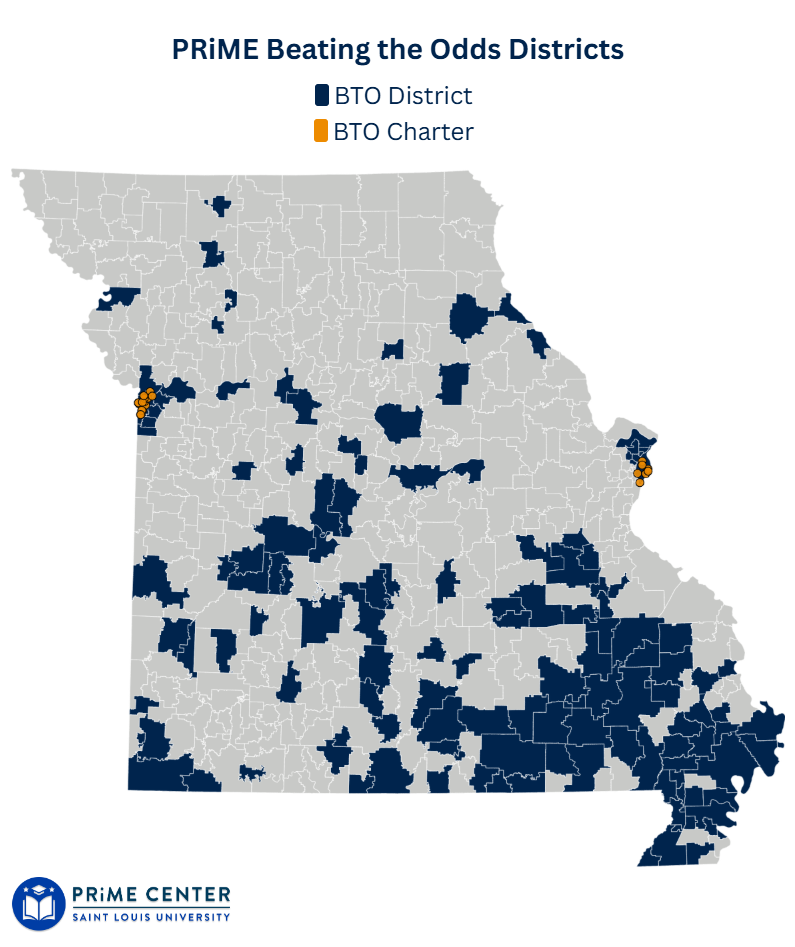
























































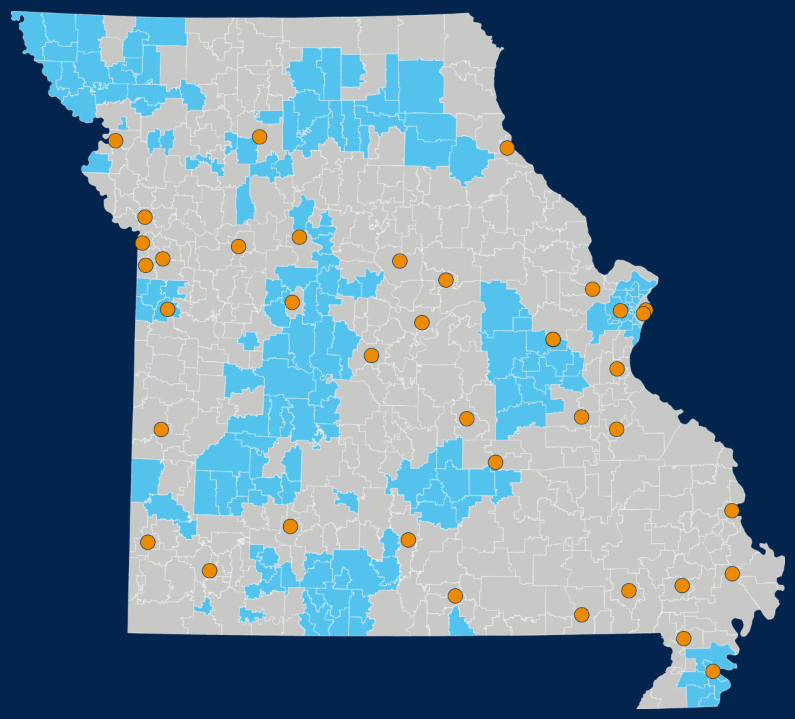
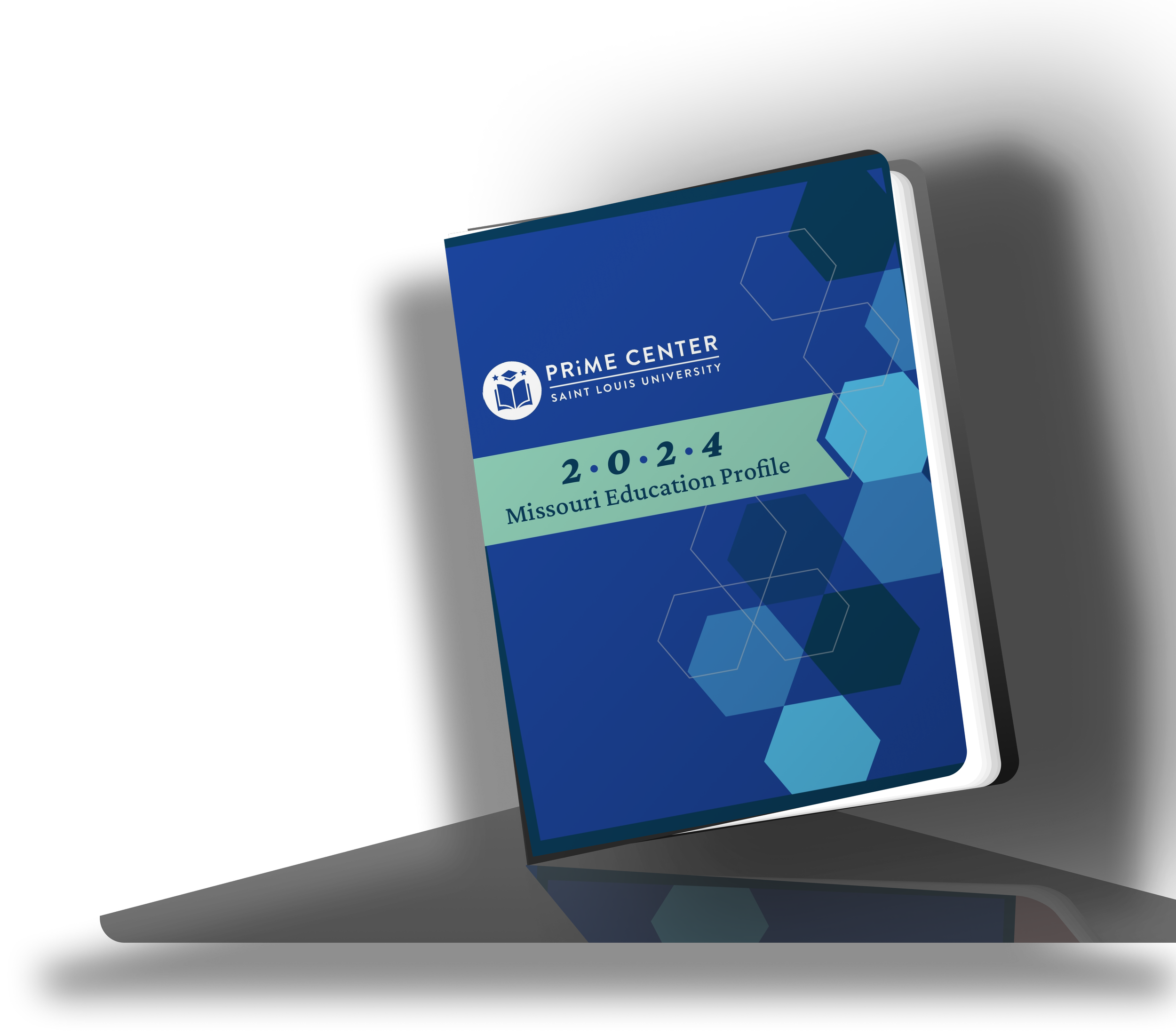



















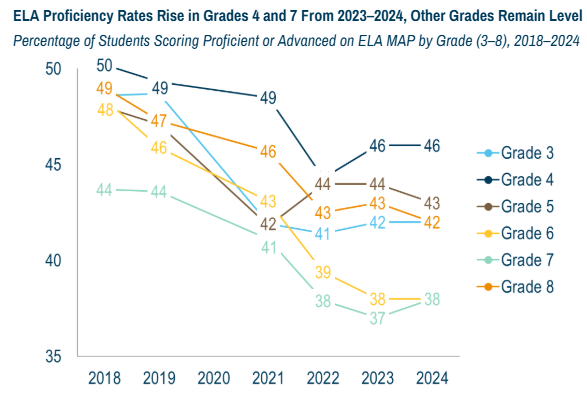






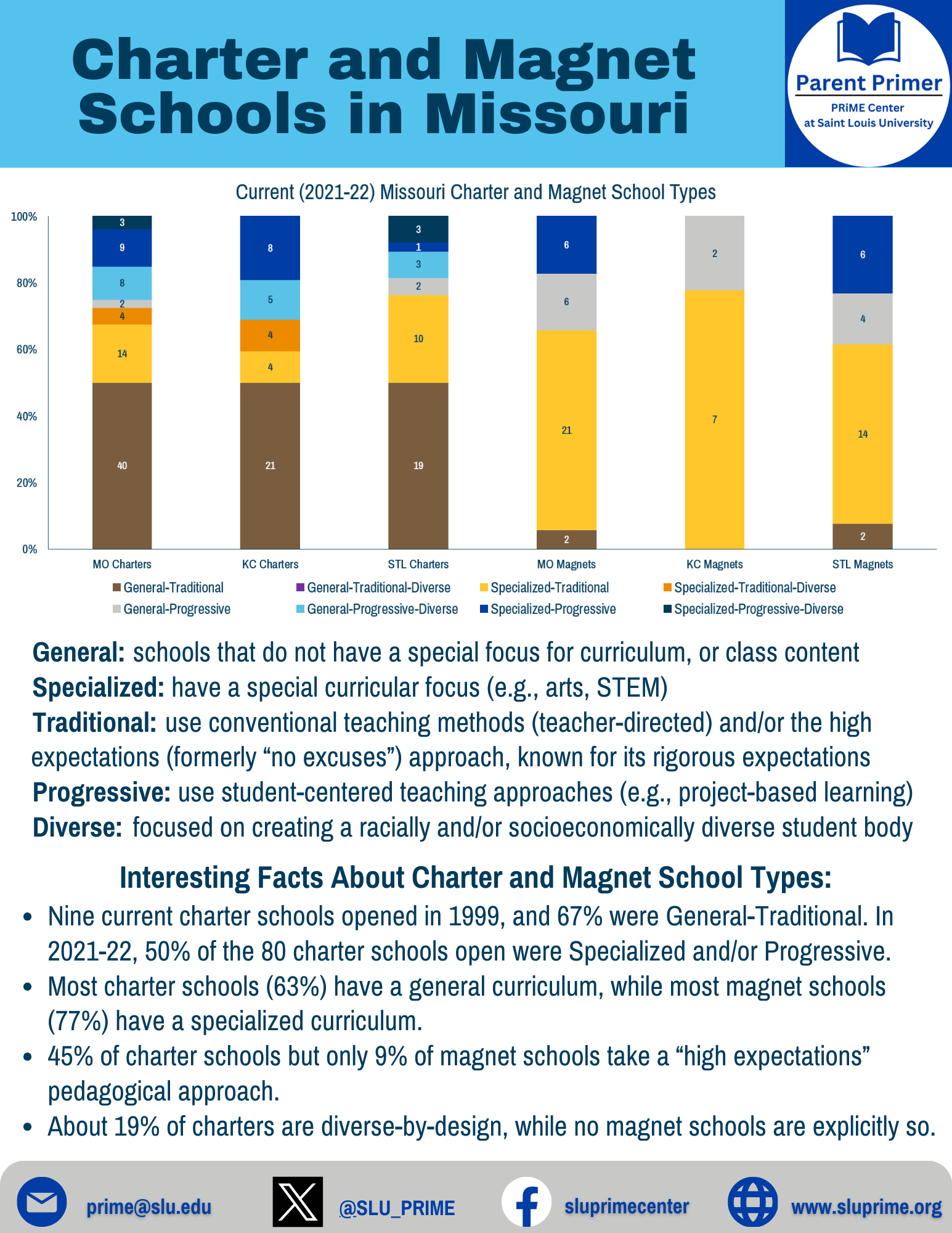





































This PRiMER on Missouri public school funding explains revenue sources, trends, formula mechanics, district expenditures, protections against enrollment decline, and fiscal reserves to provide a clear foundation for understanding Missouri’s school finance system. Over time, average per-pupil funding has risen substantially in real terms, though Missouri remains below the national average while aligning more closely with its neighboring states. Despite this equalization mechanism, wide variation in spending exists across districts, with evidence suggesting some regressive elements that benefit wealthier areas.